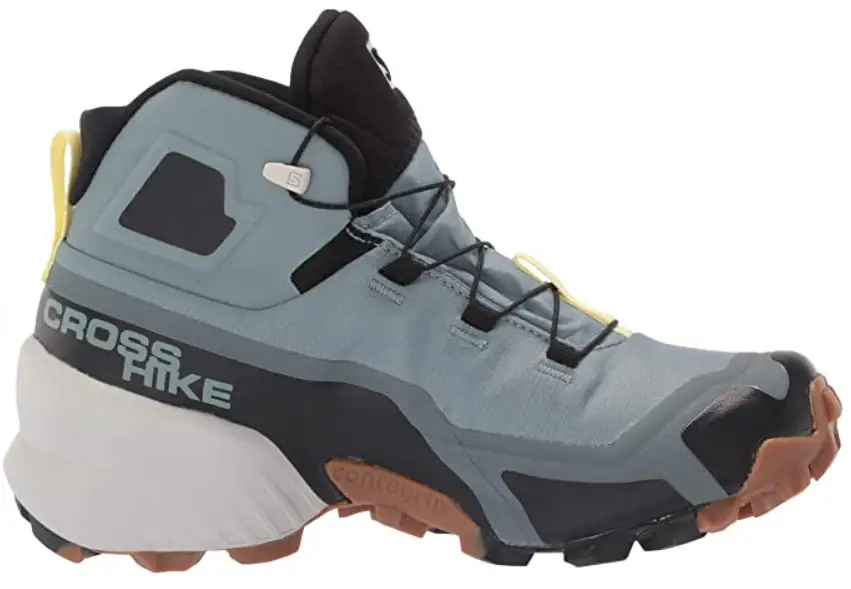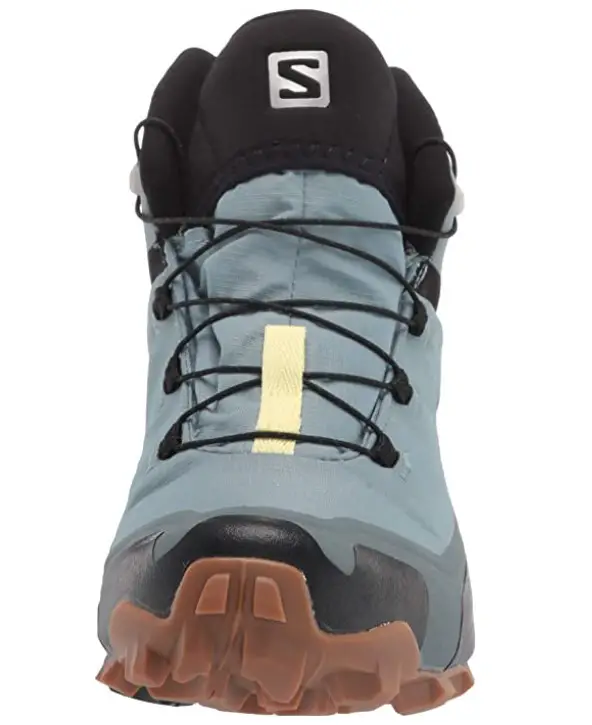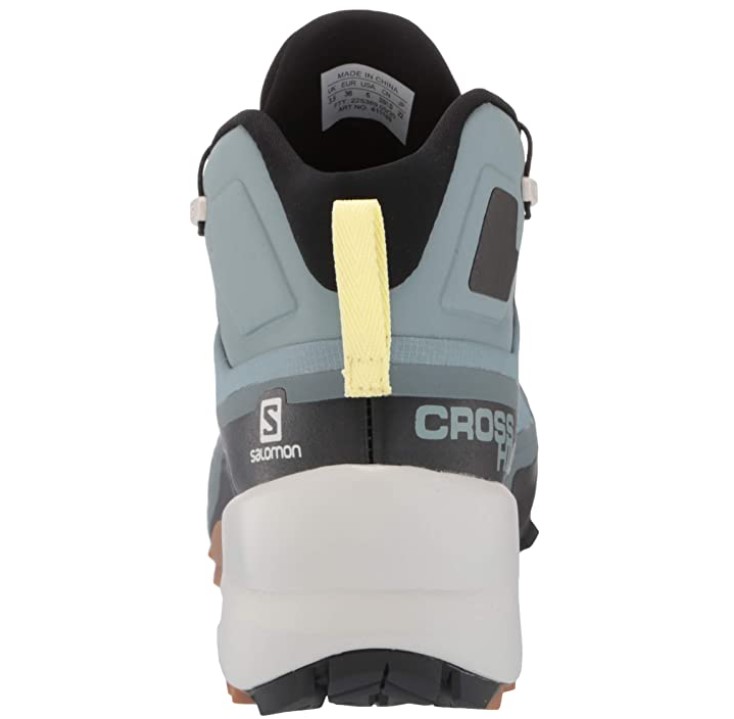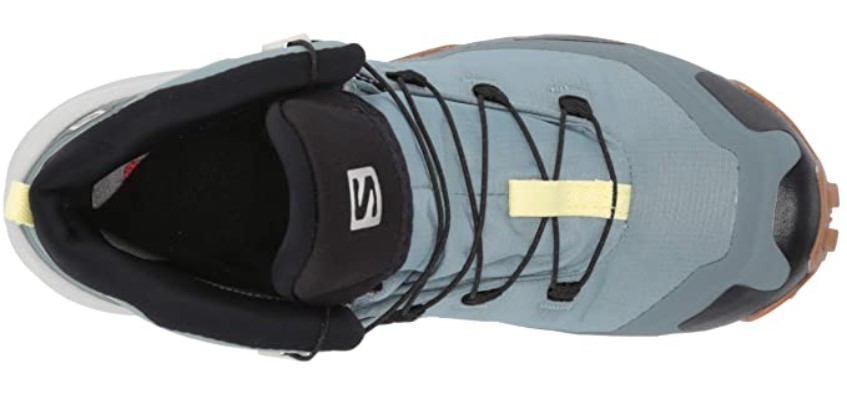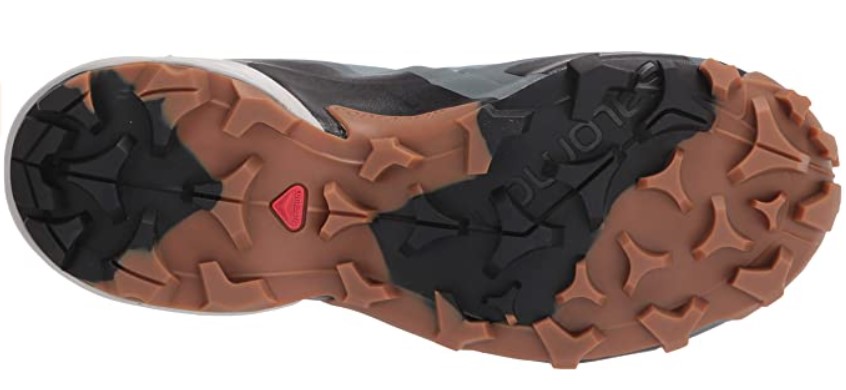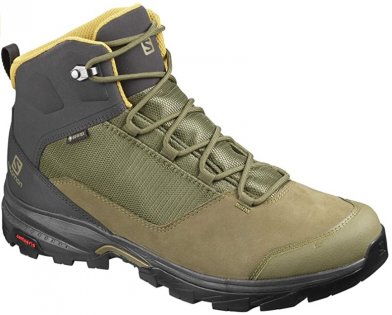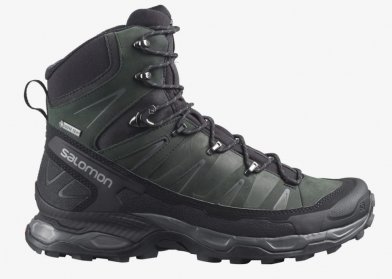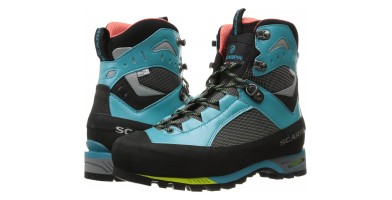Salomon Cross Hike Mid GTX Hiking Shoe
Editor’s Conclusion
Salomon's Cross Hike Mid GTX Hiking Shoe is an ambitious design.
The name Cross-Hike tells you the aims for the design purpose. To be used in all cool and wet weather terrains for trail running or hiking. With a weight that places it in the hiking shoe category while sporting an ankle boot silhouette.
This is a shoe that targets a mid-ankle boot performance. At the same time, being light enough on the feet for agility.
Choose any, cold wet, and muddy hiking environment anywhere in the world, and this middle-ground shoe/boot has been designed to go for the challenge.
The broad aim of the design is ambitious. Certainly, a shoe/ankle boot that deserves trying out in wet winter conditions for day-long hikes, with or without a light backpack. The possible pros and cons are a result of current performance, support, protection, and durability.
The name Cross-Hike tells you the aims for the design purpose. To be used in all cool and wet weather terrains for trail running or hiking. With a weight that places it in the hiking shoe category while sporting an ankle boot silhouette.
This is a shoe that targets a mid-ankle boot performance. At the same time, being light enough on the feet for agility.
Choose any, cold wet, and muddy hiking environment anywhere in the world, and this middle-ground shoe/boot has been designed to go for the challenge.
The broad aim of the design is ambitious. Certainly, a shoe/ankle boot that deserves trying out in wet winter conditions for day-long hikes, with or without a light backpack. The possible pros and cons are a result of current performance, support, protection, and durability.
Editor's Pros & Cons
Pros
Feels like a running shoe with mid boot height hiking boot performance
Good support
Light-weight
Water proof
Ankle support
Impressive traction
Styling
Quick to break-in
Cons
Durability can be challenged with extensive use
Breathability in hot weather
Practice the lace system
Some users question water proofing in serious wet conditions
Key Features
Sizing & Fit
The majority of user feedback is terrific regarding the overall fit and sizing.
Generally, this boot has space for width and length; the protected toe area has space to flex toes, and so far, no negative comments about heal slippage. The fit is good, with a comforting absence of hot spots or pressure points.
Hikers know that a standard lace-up system is useful for cinching and customizing supportive fit. This boot has the Salomon QuickLace system, so practice using the lacing system to aid with the overall fit will be needed.
Durability
A drawback from several users notes durability issues for some but not all. The uppers being prone to separating or peeling in the flexible area of the upper midfoot. Potentially, the issue might be due to the makers cutting down on weight, but it has not caused problems with waterproofing.
All other materials throughout the shoe have so far proven to be durable; the outsole is tough, the QuickLace system performs, and the lugs resist being worn down and stay effective.
WaterProofing
The Gore-Tex and waterproofing treatment for the uppers is up to the task of waterproofing. Rain, snow, sleet, walking through pooled surface water, wet mud or shallow streams do not soak the feet.
A point to keep in mind is if you step into water deep it can enter the boot via the ankle cuff. The cuff is not tight to the extent it will keep out water; if your anticipating unpredictably deep water, consider adding a gaiter for extra protection.
Breathability
The amount of breathability is exactly as you would expect when Gore-Tex is used for waterproofing.
In cool, wet seasons, the waterproofing is fine and very appreciated, but in warm, ho,t or humid weather,r you will experience warm feet. Generally, where you see Gore-Tex in footwear, it is right to assume the shoe or boot is purpose-designed for use in wet and cool conditions.
Support
Support is debatable; many users feel the support is comparable to a good hiking boot, while some say the support is similar to a trail running shoe. The general gist from users settles at the shoe being a combination of both trails running shoe and hiking boot.
The higher cut and cuff do give support, but adding in one more lace eyelet at the top might offer a chance for the lace-up system to cinch more for extra support.
Stability
Users have commented about what might be a consideration for the shoe's next upgrade. Design in an extra eye-let for the top of the lacing system. This would give hikers more control over cinching and tightening the uppers, and cuff for stability giving support. This is not so much a con but suggestions for the future.
Traction
The Contagrip outsole has a proven history as a good platform for traction. This boot also has a multi-directional tread layout and includes lugs fitted to the toe guard's front area. This feature gives traction when you run or walk up a slope.
The traction works on soggy, muddy surfaces, wet surfaces, and the usual variety of non-technical surfaces you will find on trails.
Comfort
The boot has a well-cushioned structure, no negative pressure points, and a super quick break-in time.
The OrthoLite insole offers lots of padding and a useful bounce sensation on trail surfaces—an excellent energy return from the EnergyCell+ midsole. During running or hiking, the shoe feels light, flexible, and responsive.
Users are discussing the tongue and cuff area of the shoe. The need for an additional upper eyelet to secure the tongue more firmly against the top of the foot and cuff. This would serve better to keep out grit, dust, and water.
Weight
These weigh-in for around 1 pound 9.7 ounces a pair will vary slightly by size for male or female boot versions.
The majority of user feedback is terrific regarding the overall fit and sizing.
Generally, this boot has space for width and length; the protected toe area has space to flex toes, and so far, no negative comments about heal slippage. The fit is good, with a comforting absence of hot spots or pressure points.
Hikers know that a standard lace-up system is useful for cinching and customizing supportive fit. This boot has the Salomon QuickLace system, so practice using the lacing system to aid with the overall fit will be needed.
Durability
A drawback from several users notes durability issues for some but not all. The uppers being prone to separating or peeling in the flexible area of the upper midfoot. Potentially, the issue might be due to the makers cutting down on weight, but it has not caused problems with waterproofing.
All other materials throughout the shoe have so far proven to be durable; the outsole is tough, the QuickLace system performs, and the lugs resist being worn down and stay effective.
WaterProofing
The Gore-Tex and waterproofing treatment for the uppers is up to the task of waterproofing. Rain, snow, sleet, walking through pooled surface water, wet mud or shallow streams do not soak the feet.
A point to keep in mind is if you step into water deep it can enter the boot via the ankle cuff. The cuff is not tight to the extent it will keep out water; if your anticipating unpredictably deep water, consider adding a gaiter for extra protection.
Breathability
The amount of breathability is exactly as you would expect when Gore-Tex is used for waterproofing.
In cool, wet seasons, the waterproofing is fine and very appreciated, but in warm, ho,t or humid weather,r you will experience warm feet. Generally, where you see Gore-Tex in footwear, it is right to assume the shoe or boot is purpose-designed for use in wet and cool conditions.
Support
Support is debatable; many users feel the support is comparable to a good hiking boot, while some say the support is similar to a trail running shoe. The general gist from users settles at the shoe being a combination of both trails running shoe and hiking boot.
The higher cut and cuff do give support, but adding in one more lace eyelet at the top might offer a chance for the lace-up system to cinch more for extra support.
Stability
Users have commented about what might be a consideration for the shoe's next upgrade. Design in an extra eye-let for the top of the lacing system. This would give hikers more control over cinching and tightening the uppers, and cuff for stability giving support. This is not so much a con but suggestions for the future.
Traction
The Contagrip outsole has a proven history as a good platform for traction. This boot also has a multi-directional tread layout and includes lugs fitted to the toe guard's front area. This feature gives traction when you run or walk up a slope.
The traction works on soggy, muddy surfaces, wet surfaces, and the usual variety of non-technical surfaces you will find on trails.
Comfort
The boot has a well-cushioned structure, no negative pressure points, and a super quick break-in time.
The OrthoLite insole offers lots of padding and a useful bounce sensation on trail surfaces—an excellent energy return from the EnergyCell+ midsole. During running or hiking, the shoe feels light, flexible, and responsive.
Users are discussing the tongue and cuff area of the shoe. The need for an additional upper eyelet to secure the tongue more firmly against the top of the foot and cuff. This would serve better to keep out grit, dust, and water.
Weight
These weigh-in for around 1 pound 9.7 ounces a pair will vary slightly by size for male or female boot versions.
Comparison
For comparison, you can check out another option from Salomon, the X Ultra 4 Mid GTX, which has a good tried and tested reputation.
The X Ultra has a similar light feel to a trail running shoe, but it's good for hiking, including technical trails. It works for day outings or multi-day hikes.
Another good performing option is the OUTline Mid GTX at 1 pound and 8.6 ounces and is also good for running trails or hiking. Featuring the reliable Gore-Tex lining for waterproofing. In cool and wet weather, the lug layout works well on loose, soft, smooth, and hard surfaces.
A non-Gore-Tex version is available.
The uppers are cut to sit below the ankle and do not offer the ankle protection and support given by the Cross Hike Mid GTX Hiking Shoe.
The X Ultra has a similar light feel to a trail running shoe, but it's good for hiking, including technical trails. It works for day outings or multi-day hikes.
Another good performing option is the OUTline Mid GTX at 1 pound and 8.6 ounces and is also good for running trails or hiking. Featuring the reliable Gore-Tex lining for waterproofing. In cool and wet weather, the lug layout works well on loose, soft, smooth, and hard surfaces.
A non-Gore-Tex version is available.
The uppers are cut to sit below the ankle and do not offer the ankle protection and support given by the Cross Hike Mid GTX Hiking Shoe.
Verdict
The Cross Hike Mid GTX has accumulated many appreciative users; the design purpose works for trails in any country. The various terrain surfaces, the different cooler, and wet weather conditions.
Waterproofing is clearly excellent; the traction is impressive, innovative, and durable. The amount of cushioning is popular with the versatility of a trail runner and a hiking shoe with a high ankle support design.
There are many pros, but there are cons you need to take on board for when you use these shoes. This will influence how hard you push these while out hiking in tough weather. It is clear that for day hikes, including moderate weight back-packing that this boot can perform. But some attention needs to be given to how hard you put the boot to work.
Having pointed out a few drawbacks, there are a lot of satisfied users. This suggests this shoe is worth trying out.
Waterproofing is clearly excellent; the traction is impressive, innovative, and durable. The amount of cushioning is popular with the versatility of a trail runner and a hiking shoe with a high ankle support design.
There are many pros, but there are cons you need to take on board for when you use these shoes. This will influence how hard you push these while out hiking in tough weather. It is clear that for day hikes, including moderate weight back-packing that this boot can perform. But some attention needs to be given to how hard you put the boot to work.
Having pointed out a few drawbacks, there are a lot of satisfied users. This suggests this shoe is worth trying out.





